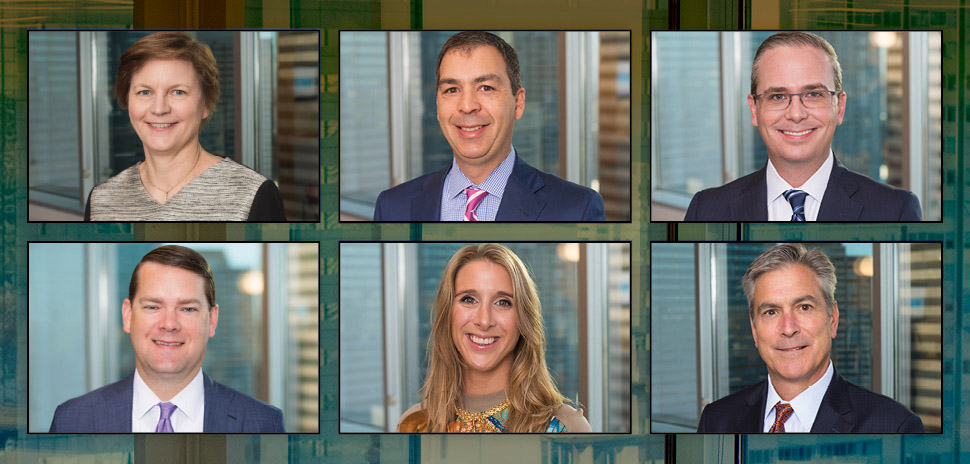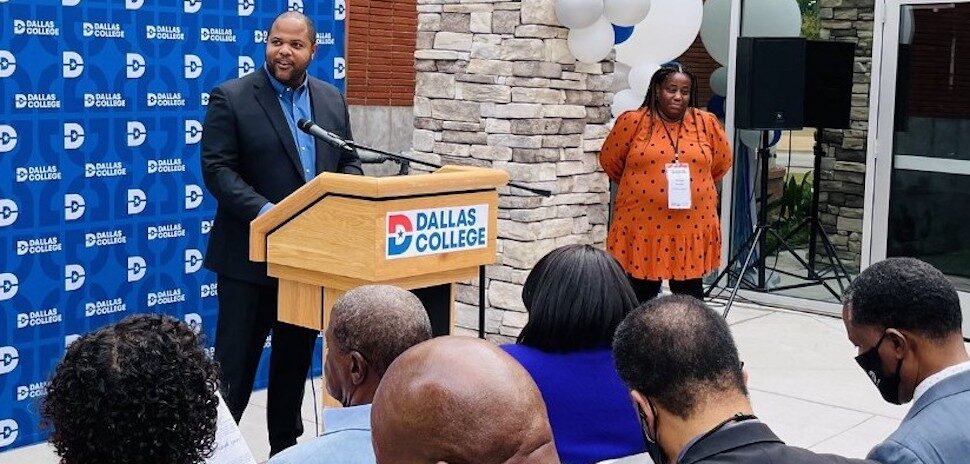![]() Dallas-Fort Worth continues to get denser and more urban, even in unlikely places like the suburbs. With that comes challenges such as gaining community support, betting on the right innovations, and—the topic on everyone’s minds—housing affordability.
Dallas-Fort Worth continues to get denser and more urban, even in unlikely places like the suburbs. With that comes challenges such as gaining community support, betting on the right innovations, and—the topic on everyone’s minds—housing affordability.
North Texas has 50,000 units of multifamily, give or take, set to be completed by the end of 2019. And we’re growing by about 150,000 people annually. Such intense growth is making the region’s multifamily housing market more interesting than ever as technology disrupters, an age-old amenities arms race, and affordability challenges shake out.
In the first installment of the three-part series on the multifamily sector in Dallas-Fort Worth, the panelists discussed the strength of the market, drivers of demand, changing demographics, and where the money is coming from.
Part Two delves deeper into the DFW multifamily market, from affordable housing and urban-suburban developments to coliving and the Airbnb influence.
Meet the Experts
P A N E L
 Sue Ansel
Sue Ansel
As CEO of Gables Residential, Sue Ansel has been with the 36-year-old company for more than 25 years. Gables owns, develops, and manages multifamily and mixed-use projects throughout major U.S. markets, accounting for 30,000 units. Locally, Gables is nearing completion of Gables Water Street in Las Colinas.
 Tom Bakewell
Tom Bakewell
Tom Bakewell co-founded StreetLights Residential in 2011 with its CEO Doug Chesnut and now serves as its President of Development. The 7-year-old company focuses on urban infill multifamily developments and has 15 projects under construction. StreetLights is nearing completion on two Dallas projects, The Christopher at The Union and The McKenzie.
 Evan Beattie
Evan Beattie
Evan Beattie is President and Senior Principal at GFF Architects. In his more than 15 years of experience, Beattie is focused on managing complex residential projects through design and construction phases. GFF is focused on urban infill mixed-use projects that often include zoning changes.
 Rob Bennett
Rob Bennett
Dallas-based Thackeray Partners invests in and acquires multifamily and industrial projects throughout the nation. As a partner, Rob Bennett has more than 15 years of experience, including more than 10 years at Thackeray, where he focuses on its multifamily platform.
 Sumner Billingsley
Sumner Billingsley
Sumner Billingsley is Vice President of Multifamily and Retail Development at Billingsley Co., the family-based development company behind projects such as International Business Park and One Arts Plaza. Sumner is primarily focused on multifamily projects at Austin Ranch and Cypress Waters.
 Paul Geyer
Paul Geyer
Paul Geyer is Managing Director at PGIM Real Estate Finance, a division of PGIM Inc., and the principal asset management business of Prudential Financial. Since his tenure began in 2002, PGIM Real Estate Finance has become one of the largest commercial and multifamily lenders in the U.S. with more than $90 billion of mortgages under management and administration.
The panel was moderated by Julia Bunch for the Dallas-Fort Worth Real Estate Review. The following transcript has been edited for Dallas Innovates.
NEW URBANISM
We have seen some recent examples of developers adapting the design of their project based on the community’s input. How does community input shape and sometimes challenge your projects?
ANSEL: We go through a prep process where we try to understand the neighborhood that we’re building in and incorporate design into that. That said, there are neighborhoods that, when a project goes through the entitlement process, they have responded and said, “You are not doing a good job of that. You are not taking our neighborhood into consideration.” So we come back with that feedback. While that adds costs and time, ultimately it’s a good thing. We have a responsibility to try to be thoughtful about that as developers. What you’ve heard all of us say today is that we think the experience that our residents have in the future is going to drive the success of our business, and there’s a different experience in each neighborhood. If you are going to be successful you need to take those experiences into consideration.
BEATTIE: Great urban design should really enrich the quality of life, not just for the people that live in the building, but those around it. Having a process where you’re asking the community about additional density and hearing concerns of the people that live around the project—it’s important. We’ve got a number of projects where community input has caused us to stop and think more carefully about access to the building and how that’s handled to make sure we minimize disruptions. We’ve, at times, without reducing the density of a project, created more community-accessible open space. It becomes the kind of thing that helps build a neighborhood. When we hear the concerns and allow them to shape the design of a building, everybody in the community feels like they can take some ownership in it. That’s good for everybody.
BENNETT: Multifamily is one of the solutions to the affordable housing issue, right? So increased density is related to lower housing cost, but that can often be at odds with what a community wants [in terms of] design requirements.
“Great urban design should really enrich the quality of life, not just for the people that live in the building, but those around it. Having a process where you’re asking the community about additional density and hearing concerns of the people that live around the project—it’s important.“
—EVAN BEATTIE
BEATTIE: So much of what happens in the engagement process adds costs to a project, which means the rents needs to go up, and it makes the product less attainable. Frequently, the people that are most impacted by the project, those who aren’t needed around it, don’t really want your project to be affordable. When we tell them we are working with the city and the city is requiring us to add affordable units, we get a negative reaction from the people that live the closest: Not in my backyard. They’re all for affordable housing, just not close to them.
ANSEL: Someone else’s neighborhood.
BEATTIE: That’s the mentality that really needs to change in Dallas. We’re too economically segregated right now. To really offer vibrant communities, we need the economic diversity that comes with having affordable housing in the best neighborhoods.
AFFORDABLE HOUSING
We all know the city of Dallas is pursuing its affordable housing policy. How will that impact your business?
GEYER: From the lending standpoint, it hasn’t impacted the underwriting as significantly, because, for affordable units, there’s typically a waiting list. Take a certain segment of your property as a lender, and say my performance shows that’s 100 percent occupied because it essentially is: We’re thinking through the operations and talking to the owner about how they are going the handle the mix of tenants. It could create a management issue in some cases, although, it’s really not seen yet. We see it in other cities where there are challenges between the two, but as time goes on, they smooth out. Residents get to know each other. There’s a sense of community that can be developed. As a lender—we just observe. So it’s kind of like being an uncle: You can drop off the kid after you had a fun time and put him back with his parents. We deal with properties the same way with a lender. A lot of what we’ve heard is the management challenges when it first gets introduced. But from an underwriting standpoint, it’s been pretty easy to handle.
BAKEWELL: We kind of do the same thing. When we’re looking at a property where there [might be] 400 units, we don’t want to build that many units, [and] 75 of them are affordable. So we take those out of the equation when we’re looking at the viability of the property because we know those will lease out very quickly.
“As a lender—we just observe. So it’s kind of like being an uncle: You can drop off the kid after you had a fun time and put him back with his parents.”
—PAUL GEYER
BEATTIE: An ordinance that’s working its way through Dallas right now is incentive-based. It’s taking low-density residential MF1 – MF2 and U1 – U2 [zoning classifications] and increasing by right entitlements if affordable units are provided. I think we’re going to see the ad hoc approach to zoning changes for high-rises and high-density projects that aren’t in those zoning classifications. But increasing density to have affordable units is going to happen because people look at MF1 and MF2 properties as being markets for good investment. There will be more quality development happening in places where it’s needed in Dallas, where there is very old Class B and C product that’s way beyond its life cycle. Dallas is having issues with code enforcement in a lot of these old properties where they can’t keep up, and the best thing for the city is for a lot of that product to be rebuilt so it can accommodate the people who were living in that property at a higher style and standard.
BENNETT: We need to acknowledge that The Real Estate Council (TREC) has done great work. I think the industry has to be a part of the decision on how this affordable housing issue evolves. It’s not easy. In some ways, we don’t know what the target is and what we’re aiming for. So engaging the business community in the discussion of how you address affordable housing—a way to where it incentivizes the business community to invest—that’s the real key component. TREC needs recognition for a lot of hard work that’s gone into that.
BAKEWELL: It’s early. There’s still a lot to be figured out. I mean, they figured out we need 20,000 units (The city of Dallas estimates another 20,000 affordable housing units are needed—and not just in low-income areas, according to reports earlier this year.) They’ve also quantified how much money is needed, but haven’t figured out where that money is coming from. What I hope they do is they make it a city issue that the entire city resolves first.
“Engaging the business community in the discussion of how you address affordable housing—a way to where it incentivizes the business community to invest—that’s the real key component.”
—ROB BENNETT
ANSEL: It’s a big issue all over the country, and it’s being addressed at a city level as opposed to a state or a national level. To your point, Tom, it’s not appropriate that the burden gets placed entirely on the multifamily industry. I think there needs to be a public-private solution to that. Maybe one size doesn’t fit all, but without a doubt, the country has a workforce and affordable housing shortage. We need to figure a better solution.
BEATTIE: With regulations and limited supply, the result will be higher rents and less obtainable housing for everyone. We need regulations that incentivize and increase supply to keep rents attainable.
Linda McMahon, president and CEO of The Real Estate Council, joined the conversation.
LINDA MCMAHON: One of the successes of what we’ve been able to do with the city has been driven by the industry being at the table and really providing solutions. There’s a challenge for people to understand the complexity of financing and what their investors want. When you’re putting together a project that’s going to have a housing affordability component to it, give us some insight as to what you have to deal with in terms of investors and debt providers and agencies. What does the pitch look like from a regulatory perspective?
ANSEL: Today, the requirements aren’t uniform. So when we’re talking to investors, it’s hard to be specific because the regulations in Boston or Washington, D.C. are very different than the regulations —or the proposed regulations—in other markets. Our investors recognize the importance of affordable housing, so they are generally supportive of it. But, my experience is for our fund level, and a lot of our investors are pension fund investors, so they really care about it. They don’t get into a level of detail based on what might be in any specific market.
“One of the successes of what we’ve been able to do with the city has been driven by the industry being at the table and really providing solutions.”
—LINDA McMAHON
MCMAHON: For a while, there was a trend of socially responsible funds. I think Credential may have had some at one point. Do you see that shifting back to having more of those funds where they are willing to take a lower return in exchange for social benefits?
BENNETT: Yes, you have investors who would like to have social sustainable components. They care about where we’re going and are willing to look at deals that have that component to it. It’s a lack of clarity that is the biggest challenge. If you’re talking to equity, they just want to know: “I have got enough moving parts and risks in other aspects of the project, and I just need to know what my target is.” If that’s going to be a 20 percent affordability requirement, that would be high, relatively speaking. And that’s okay. They just have to be able to underwrite it and know with a relative degree of certainty that it won’t move from the day they started looking at the deal to the day they fund the check. That’s not where we are yet.
BAKEWELL: The challenge is that “sweeter” project, right? That fund would rather invest in a 100 percent workforce housing project than one that has 20 percent affordable units and the 80 percent the aftermarket rents, which is typically what you have there. Then, that person out there who is trying to get it the more traditional way—20 percent affordable in Dallas right now—can say, “OK, I have five options over here that have no affordability versus your project. I’m going to pick one of these other properties, because I know my return opportunity is going to be higher there.”
But, if it’s at the point where four out of five projects in Dallas have 20 percent affordable, then it becomes expected. In a lot of markets we deal in, it’s expected: “How many available units do you have?” They know that you are going to have them. So they expect that, and they get used to it. It’s just going to be those first few years here in Dallas until it starts rolling and then becomes commonplace.
GEYER: There’s an industry perspective that being too early is the same as being too late, to get back to the pioneering theme. What you are seeing on the social responsibility side is that banks have had it for a while. We, as a firm, think it’s very important and have done it as well. I think what you are seeing is not so much taking a lesser return for that, but more about not charging risk premium because it’s pioneering. It’s a risky asset, and it’s a risky loan that you’re going to make. If you go into an area and start re-gentrification over an area that really needs new capital investment, there’s a premium that typically needs to be charged by the investors. I think it’s trying to pick the right projects, and not charging the premium—putting them on kind of the same spectrum as what would be the more established or more upscale project, where the neighborhood has a track record. If you can get to the level where you’re not charging a risk premium, I think it can create an investment that will rise and can really build up.
What are the unique challenges of bringing a really dense urban project to a suburb?
BEATTIE: I think the [Dallas North] Tollway and [State Highway] 121 is becoming a new town for our region. It’s the suburbs—Plano and Frisco—but their job creation is creating a new downtown. I think in the next decade, we’ll start thinking of it that way. We did the residences at Legacy from Trammel Crow Co., which is a high-rise that’s wrapping up construction now. It’s every bit as nice as Park District in downtown Dallas. They want the same experience that’s being offered in uptown. Legacy West is trying to replicate the walkability and urban environment we have in downtown [Dallas].
BAKEWELL: I think the demand for that will be limited. When you look at Uptown, you’ve got some four- or five-story wood-framed properties and a lot of high-rises that have been built lately. The rent differential in those four-story wood-framed building are still getting $2.30 [in rent per] square foot. They are big rents. So the leap up to the high-rises is not as big when you get to the suburbs, and your rents are $1.35 [per foot]. They’re shaving off land, but their construction cost is the same to build that product up in Legacy as it is down here. So, the rent they need is not too far off from what they need down here. I don’t think there are that many people that would say, “OK, my alternative to rent is a third of what it is to rent here.” I do think there will be a number of people who will do that. I’m sure it is very nice. There are some good views. But I think it’s a more limited market for that.
BEATTIE: That’s where the jobs are. With the job creation that’s happening up there, people are relocating to our region from California where they have had a more urban environment. They don’t want to live on a half-acre in north Frisco. There’s a demographic that wants to be in that kind of [urban] environment.
BILLINGSLEY: Playing off that, we aren’t doing high-rises out in the ‘burbs. We have one project that is seven stories, and it’s a colossal tower to us. What we’re doing is trying to take into account that people are moving here from the West Coast and the East Coast. And, just because their company is based in North Dallas, doesn’t mean they don’t want a sort of Uptown or West Village urban energized experience. They also don’t want to sit in their car for an hour and a half in traffic going back and forth each day. So we’ve put a ton of thought into that.
The Brickyard was the first project I worked on from start to finish here, and it’s at I-635 and I-35 at Mercer Crossing. If you drove out to it when it was under construction, there was one office building and a lake on one side. It backs up to a canal. It was all field at the time. We built romantic, industrial, New York-inspired architecture out there, but we made all the streets flush with the curb so it feels more urban. We looked at Portland. We looked at New York. We did sunken stoops and elevated stoops, and used quality materials that felt urban. I was very diligent about [our landscaping]. We didn’t want yards. We did hard scape and potted trees. We carried that urban architecture through to the landscaping, and we were really nervous about it. My mom [Lucy Billingsley] was terrified when we were doing it because there wasn’t any other multifamily out there around us. It ended up being our fastest lease up that we’ve had to date. There’s a real hunger and thirst for that sort of architecture out in the suburbs, and a lot of what they’d been seeing didn’t have that “extra” to it. Whether it’s high-rise or not, I think there is a definite desire to have the urban experience in the suburbs.
BAKEWELL: The struggle is being the pioneer to do it, right, because you don’t have comps that could support and say, “OK, I’m going to build like this and get these rents.” When they are out trying to get financing, either equity or debt, you’ve got to sell the lender on “This is our dream. This is how we think it’s going to work.” They’ll say, “Where are your comps?” We did McKenzie, and it was the same thing. We started out with wanting to build 2,300-square-foot units. I couldn’t that financed. The cost basis was too high, and we pulled it back to 1,600 square feet. And that was still a struggle to get it done. Today, I think the second one would be a lot easier because I can show how the other one went. But being the first to do anything is really the hard part.
“What we’re doing is trying to take into account that people are moving here from the West Coast and the East Coast. And, just because their company is based in North Dallas, doesn’t mean they don’t want a sort of Uptown or West Village urban energized experience.”
—SUMNER BILLINGSLEY
BEATTIE: Victory Park is a good example of that. We’re seeing the region trying to create new districts from scratch, and it’s very difficult to create a successful urban environment. I think Victory Park 2.0 is going to be really successful. The high-rises that have been delivered recently there are all competing with each other, and they are probably not where the developers would like them to be, but there’s a new wave of restaurants that are going to be open in the next couple of months that’s will interject new street life there. It will be successful eventually — but just like you said, it’s the pioneering large-scale mixed-use developments that are very tough to execute.
BAKEWELL: We’ve seen neighborhoods develop. Before, it was Uptown and the suburbs, but now we’ve got West Dallas, Victory, and Deep Ellum. You can pick the neighborhood based on your taste and what you want.
BILLINGSLEY: I think Dallas … is going to become more like LA where people don’t want to spend any more time in their car than they have to. The pocket neighborhoods are going to get stronger and stronger identities, because people are going to want to have a neighborhood bar, and they are going to want to have a healthy, funky grocery store — or whatever it is that really gives them a sense of community and identity. They’re not going to want to drive 50 miles to go to their favorite restaurant.
“We’ve seen neighborhoods develop. Before, it was Uptown and the suburbs, but now we’ve got West Dallas, Victory, and Deep Ellum. You can pick the neighborhood based on your taste and what you want.”
—TOM BAKEWELL
CO-LIVING + MICRO-UNITS
What about co-living? Is that something that you are engaging in, financing, or designing?
BEATTIE: We’ve had micro-unit projects that have had a difficult time moving forward. You’re getting the units as small as you can to make them very attainable and getting rid of all, or most of, the parking to try and get somebody into an urban location where they might otherwise not be able to afford it, or you’re trying to capture that traveling person who’s in the city three, four days a week. I see a lot of that in Austin and in Dallas.
BAKEWELL: With the younger demographic in Austin [where] costs are a lot higher—it’s become a necessity.
BILLINGSLEY: In a city like New York where people are constantly coming out for two, three months of training … I think a place with that sort of density and turnover makes sense.
BEATTIE: People in Texas like their privacy. The rents are low enough here that you can get a small one bedroom or efficiency that’s preferable to living with somebody else for a month.
ANSEL: The turnover rate is a lot higher on micro-units. From a cost standpoint and operating ability long-term, they’re more costly to build, because the most expensive part is your bathrooms and your kitchens, and you still need that.
BEATTIE: When you start getting really small, you start looking at Murphy beds and built-in furniture and—
BAKEWELL: That’s more expensive.
ANSEL: You’re providing it as opposed to the residents bringing it.
Multifamily and Airbnb have not always seen eye to eye. Now, we’re hearing about the company’s new “tool kit” of investments, as well as developments that are Airbnb branded (in Florida). What’s the impact of that Airbnb influence and the overall sharing economy on multifamily?
ANSEL: There are clearly some residents—the millennials—who are used to a sharing economy, so they are very welcoming. They would love to find a way to drive an offset to their rents. The older generation—Gen X, Baby Boomers—are not as comfortable with the sharing economy. When we poll our residents, 40 percent want it, 40 percent don’t, and 20 percent don’t know. And, quite honestly, we have some concerns about the way it’s been proposed to-date, with respect to fair housing regulations. So there are challenges. That said, it’s not permitted currently in the standard lease. We’re open to a solution. I don’t think we’ve found it yet. There are people who are looking at it creatively, [such as] carving out the floor with separate access. It’s a part of the disruptive technology, and we’re at the beginning of finding a happy medium.
GEYER: I think it’s an extension of corporate housing that leaves several units to a corporate housing provider and the tenants turnover, but there’s a liability there to that corporate housing provider. It doesn’t quite seem to be there yet on Airbnb.
ANSEL: Some Airbnb-type organizations or Airbnb itself are now putting in noise meters in every unit that is rented as an Airbnb unit. I mean, look, it is going to evolve.
“There are clearly some residents—the millennials—who are used to a sharing economy, so they are very welcoming. They would love to find a way to drive an offset to their rents. The older generation—Gen X, Baby Boomers—are not as comfortable with the sharing economy. When we poll our residents, 40 percent want it, 40 percent don’t, and 20 percent don’t know.”
—SUE ANSEL
BAKEWELL: We’re looking at a development in Gilbert, Arizona, and it’s very unique. It’s an old farmstead that has been developed out. It’s a varied community—a social-based property. The homes that are in there all have low-front porches and shared yards. One of the ordinances they have in place that’s a deed restriction is you cannot rent out your home to anybody. The exception is, if you rent out your home, then you have to live in a back house. You have to be living on-site when you rent that house, so you don’t have an absentee landlord who doesn’t know what’s going on there. If they have a party, you know what’s going on, and you can stop it. That’s an interesting way to deal with that. For an apartment, it would be hard to do, unless you’re renting out a room, but it was just a thought.
Don’t miss Part Three of the Multifamily roundtable series: Sign up for the Dallas Innovates e-newsletter here.
A version of this article appeared in the Dallas-Fort Worth Real Estate Review, Summer 2018.
READ NEXT
DALLAS-FORT WORTH: A MARKET IN MOTION
A PANEL OF EXPERTS ON MULTIFAMILY REAL ESTATE IN THE REGION
PART ONE
Ch-Ch-Changes: Dallas-Fort Worth Multifamily Experts Talk About a Market in Motion
In the first of a three-part series on the multifamily sector in Dallas-Fort Worth—a “Market in Motion”—expert panelists discuss the strength of the market, the drivers of demand, changing demographics, and where the money is coming from.
PART TWO
Market in Motion: Multifamily Experts on Density, Affordable Housing, and Community Engagement in Development
Part Two delves deeper into the multifamily market, looking at ways the business community drives success, the ins and outs of affordability, urban-suburban developments, co-living, the challenges that come with the urban experience, and the Airbnb influence.
PART THREE
Market In Motion: ‘How Do You Design and Adapt In An Environment Where You Know it Will be Different Tomorrow?’
In Part Three—the last in the series—the real estate experts discuss the multifamily sector: How amenities have evolved, the rise of IoT and emerging technologies, disruptive trends, the impact of transportation, sustainability, and what the future holds.
Dallas Innovates, Every Day: Sign up for the enewsletter.
MORE ON REAL ESTATE
Green Building Public & Education LEED-ers in Dallas-Fort Worth
Developers, designers, and cities are pushing sustainability forward in North Texas, creating friendly and beautiful structures.
13 Pioneering DFW Projects In LEED
Developers, designers, and cities are pushing sustainability forward
Placemakers: For Todd Interests, Revitalizing a Downtown Dallas Neighborhood is a Family Affair
East Quarter continues Todd Interests’ track record of investing in properties and turning them into unique landmarks in the city.


































































